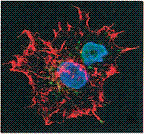Biochemistry, Department of

Gautam Sarath Publications
Document Type
Article
Date of this Version
11-1-2004
Abstract
The tertiary structure of a maize (Zea mays ssp. mays) non-symbiotic hemoglobin (Hbm) was modeled using computer tools and the known tertiary structure of rice Hb1 as a template. This method was tested by predicting the tertiary structure of soybean leghemoglobin a (Lba) using rice Hb1 as a template. The tertiary structures of the predicted and native Lba were similar, indicating that our computer methods could reliably predict the tertiary structures of plant Hbs. We next predicted the tertiary structure of Hbm. Hbm appears to have a long pre-helixA and a large CD-loop. The positions of the distal and proximal His are identical in Hbm and rice Hb1, which suggests that heme-Fe is hexacoordinate in Hbm and that the kinetic properties of Hbm and rice Hb1 are expected to be very similar, i.e. that Hbm has a high O2-affinity. Thermostability analysis showed that Hbm CD-loop is unstable and may provide mobility to amino acids located at the heme pocket for both ligand binding and stabilization and heme-Fe coordination. Analysis of the C-terminal half of Hbm showed the existence of a pocket-like region (the N/C cavity) where interactions with organic molecules or proteins could be possible. Lys K94 protrudes into the N/C cavity, suggesting that K94 may sense the binding of molecules to the N/C cavity. Thus, it is likely that the instability of the CD-loop and the possibility of binding molecules to the N/C cavity are essential for positioning amino acids in the heme pocket and in regulating Hbm activity and function.


Comments
Published in Plant Physiology and Biochemistry 42 (2004) 891–897.